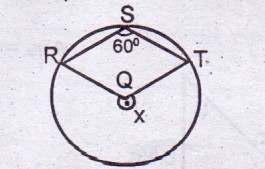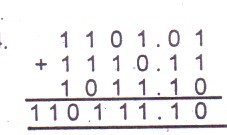2017 - JAMB Mathematics Past Questions and Answers - page 2
11
Simplify 3 \(^{n − 1}\) × 27 \(\frac{n + 1}{81^n}\)
A
3\(^{2n}\)
B
9
C
3n
D
3 \(^{n + 1}\)
Ask EduPadi AI for a detailed answer
Share this question
12
The locus of a point which is equidistant from the line PQ forms a
A
circle centre P
B
pair of parallel lines each opposite to PQ
C
circle centre Q
D
perpendicular line to PQ
Ask EduPadi AI for a detailed answer
Share this question
13
Given T = {even numbers from 1 to 12}
N = {common factors of 6, 8 and 12} Find T, N
N = {common factors of 6, 8 and 12} Find T, N
A
{2, 3}
B
{2, 3, 4}
C
{3, 4, 6}
D
{2}
Ask EduPadi AI for a detailed answer
Share this question
14

A
100o
B
140o
C
120o
D
10o
Ask EduPadi AI for a detailed answer
Share this question
15
Find the sum of the range and the mode of the set of numbers 10, 9, 10, 9, 8, 7, 7, 10, 8, 10, 8, 4, 6, 9, 10, 9, 7, 10, 6, 5
A
16
B
14
C
12
D
10
Ask EduPadi AI for a detailed answer
Share this question
16
Find the sum to infinity of the series
\(\frac{1}{4}\), \(\frac{1}{8}\), \(\frac{1}{16}\),..........
\(\frac{1}{4}\), \(\frac{1}{8}\), \(\frac{1}{16}\),..........
A
\(\frac{1}{2}\)
B
\(\frac{3}{5}\)
C
\(\frac{-1}{5}\)
D
\(\frac{73}{12}\)
Ask EduPadi AI for a detailed answer
Share this question
17

A
6
B
2
C
4
D
5
Ask EduPadi AI for a detailed answer
Share this question
18
The value of x + x ( xx) when x = 2 is
A
16
B
10
C
18
D
24
Ask EduPadi AI for a detailed answer
Share this question
19
In a regular polygon, each interior angle doubles its corresponding exterior angle. Find the number of sides of the polygon
A
8
B
6
C
4
D
3
Ask EduPadi AI for a detailed answer
Share this question
20
A cylindrical tank has a capacity of 3080m3. What is the depth of the tank if the diameter of its base is 14m? Take pi = 22/7.
A
23m
B
25m
C
20m
D
22m
Ask EduPadi AI for a detailed answer
Share this question